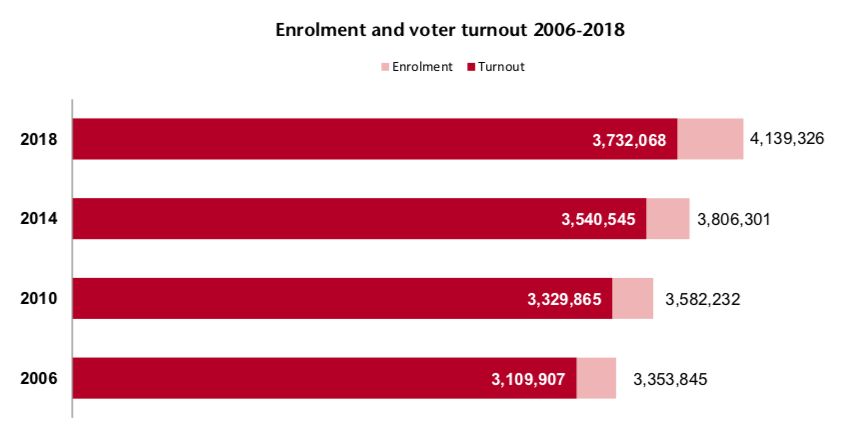The Victorian Electoral Commission has published more information about turnout at the 2018 state election as part of their submission to the inquiry into that election, with some interesting bits I wanted to pull out. In particular, there’s evidence that turnout dropped due to an increase in enrolment, but the proportion of the eligible population who have cast a vote is higher than at recent elections.
The turnout as a proportion of the enrolled population was the lowest in many decades, at 90.2%. With the exception of two elections in the 1940s, this was the lowest turnout since the introduction of compulsory voting in the 1920s.
Federal evidence suggests increased enrolment at recent elections has lowered turnout while still increasing the proportion of the eligible population who vote. Similarly it looks like the proportion of the voting eligible population who have cast a vote has increased from 84.5% in 2010 to 87.1% in 2018.
This is primarily explained by increased enrolment levels. 90.9% of the eligible population was enrolled in 2010, and this had increased to 96.6% in 2018.
The VEC points to two specific processes that had an effect on enrolment rates.
Turnout was lower for those who were enrolled in the “direct enrolment” process, where the VEC is able to enrol voters without a proactive enrolment application form using other government data. Of the 324,501 electors who were enrolled through this process since 2017, the turnout rate was only 72.2%. The direct enrolment program has expanded significantly since 2014, which seems to have had an effect of increasing enrolment and total voter numbers but depressing the turnout figure.
Turnout was also lower amongst those who enrolled as part of the 2017 marriage law postal survey. 35,730 electors enrolled in the lead-up to the survey, and the turnout amongst that group was only 67.9%. It’s worth noting that this is a relatively small group compared to overall youth enrolment.
Interestingly, there was a big gap in turnout between younger and older voters who enrolled during the marriage survey. Those aged under 20 turned out at a rate of 91%. These would’ve mostly been voters who would normally get around to enrolling for a major election and did so before the survey since it was their first opportunity to cast a vote. Those electors who enrolled in the lead-up to the survey who were aged in their 20s had a much lower turnout – just 55.8% voted. Those people who had enrolled for the marriage survey after resisting enrolment for earlier elections appeared much less likely to want to vote in a state election.
- Overall the trend is consistent with what we saw in the federal election: higher enrolment levels make turnout look lower, but the proportion of the eligible population who are voting is going up.




I suspect that many of the newly automatically enrolled non-voters at this election will turn out next time, after being fined this time. Maybe the informal vote will increase (at least in seats where it was not unusually high at this election due to candidate numbers).
“Compulsory” voting works for democracy in Australia compared with other countries, even the much loved motherlands (UK & Ireland) and the politically dysfunctional USA who have non compulsory voting.
Comments are closed.